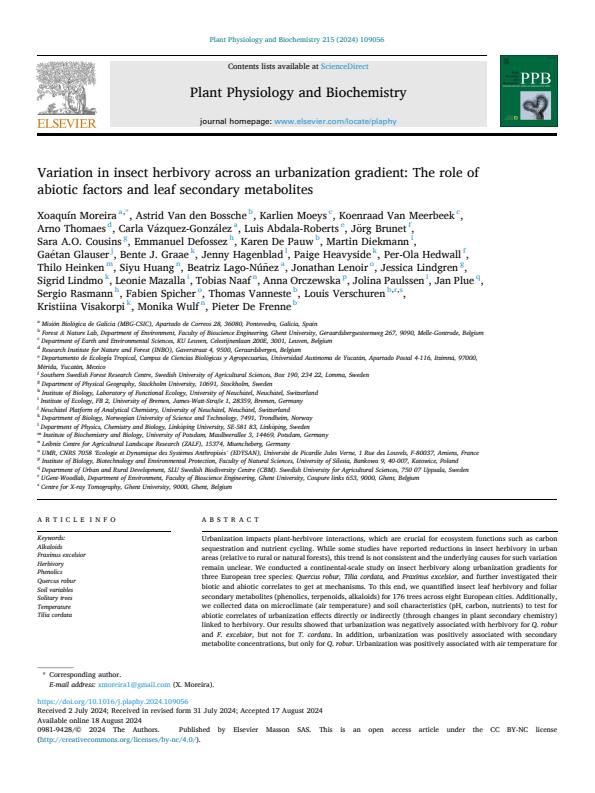Variation in insect herbivory across an urbanization gradient: The role of abiotic factors and leaf secondary metabolites
biotic and abiotic correlates to get at mechanisms. To this end, we quantified insect leaf herbivory and foliar secondary metabolites (phenolics, terpenoids, alkaloids) for 176 trees across eight European cities. Additionally, we collected data on microclimate (air temperature) and soil characteristics (pH, carbon, nutrients) to test for abiotic correlates of urbanization effects directly or indirectly (through changes in plant secondary chemistry) linked to herbivory. Our results showed that urbanization was negatively associated with herbivory for Q. robur
and F. excelsior, but not for T. cordata. In addition, urbanization was positively associated with secondary metabolite concentrations, but only for Q. robur. Urbanization was positively associated with air temperature for Q. robur and F. excelsior, and negatively with soil nutrients (magnesium) in the case of F. excelsior, but these abiotic variables were not associated with herbivory. Contrary to expectations, we found no evidence for indirect effects of abiotic factors via plant defences on herbivory for either Q. robur or F. excelsior. Additional biotic or
abiotic drivers must therefore be accounted for to explain observed urbanization gradients in herbivory and their interspecific variation.
Details
| Number of pages | 9 |
|---|---|
| Volume | 215 |
| Type | A1: Web of Science-article |
| Category | Research |
| Magazine | Plant Physiology and Biochemistry |
| Language | English |
Bibtex
@misc{5e5314ff-3654-4d9e-9bce-71834b6c845f,
title = "Variation in insect herbivory across an urbanization gradient: The role of abiotic factors and leaf secondary metabolites",
abstract = "Urbanization impacts plant-herbivore interactions, which are crucial for ecosystem functions such as carbon sequestration and nutrient cycling. While some studies have reported reductions in insect herbivory in urban areas (relative to rural or natural forests), this trend is not consistent and the underlying causes for such variation remain unclear. We conducted a continental-scale study on insect herbivory along urbanization gradients for three European tree species: Quercus robur, Tilia cordata, and Fraxinus excelsior, and further investigated their
biotic and abiotic correlates to get at mechanisms. To this end, we quantified insect leaf herbivory and foliar secondary metabolites (phenolics, terpenoids, alkaloids) for 176 trees across eight European cities. Additionally, we collected data on microclimate (air temperature) and soil characteristics (pH, carbon, nutrients) to test for abiotic correlates of urbanization effects directly or indirectly (through changes in plant secondary chemistry) linked to herbivory. Our results showed that urbanization was negatively associated with herbivory for Q. robur
and F. excelsior, but not for T. cordata. In addition, urbanization was positively associated with secondary metabolite concentrations, but only for Q. robur. Urbanization was positively associated with air temperature for Q. robur and F. excelsior, and negatively with soil nutrients (magnesium) in the case of F. excelsior, but these abiotic variables were not associated with herbivory. Contrary to expectations, we found no evidence for indirect effects of abiotic factors via plant defences on herbivory for either Q. robur or F. excelsior. Additional biotic or
abiotic drivers must therefore be accounted for to explain observed urbanization gradients in herbivory and their interspecific variation.",
author = "Xoaquín Moreira and Astrid Van den Bossche and Karlien Moeys and Koenraad Van Meerbeek and Arno Thomaes and Carla Vázquez-González and Luis Abdala-Roberts and Jorg Brunet and Sara A. O. Cousins and Emmanuel Defossez and Karen De Pauw and Martin Diekmann and Gaétan Glauser and Bente J. Graae and Jenny Hagenblad and Paige Heavyside and Per-Ola Hedwall and Thilo Heinken and Siyu Huang and Beatriz Lago-Núñez and Jonathan Lenoir and Jessica Lenoir and Sigrid Lindmo and Leonie Mazalla and Tobias Naaf and Anna Orczewska and Jolina Paulssen and Jan Plue and Sergio Rasmann and Fabien Spicher and Thomas Vanneste and Louis Verschuren and Kristina Visakorpi and Monika Wulf and Pieter De Frenne",
year = "2024",
month = oct,
day = "01",
doi = "https://doi.org/10.1016/j.plaphy.2024.109056",
language = "English",
publisher = "Instituut voor Natuur- en Bosonderzoek",
address = "Belgium,
type = "Other"
}
Authors
Xoaquín MoreiraAstrid Van den Bossche
Karlien Moeys
Koenraad Van Meerbeek
Arno Thomaes
Carla Vázquez-González
Luis Abdala-Roberts
Jorg Brunet
Sara A. O. Cousins
Emmanuel Defossez
Karen De Pauw
Martin Diekmann
Gaétan Glauser
Bente J. Graae
Jenny Hagenblad
Paige Heavyside
Per-Ola Hedwall
Thilo Heinken
Siyu Huang
Beatriz Lago-Núñez
Jonathan Lenoir
Jessica Lenoir
Sigrid Lindmo
Leonie Mazalla
Tobias Naaf
Anna Orczewska
Jolina Paulssen
Jan Plue
Sergio Rasmann
Fabien Spicher
Thomas Vanneste
Louis Verschuren
Kristina Visakorpi
Monika Wulf
Pieter De Frenne

